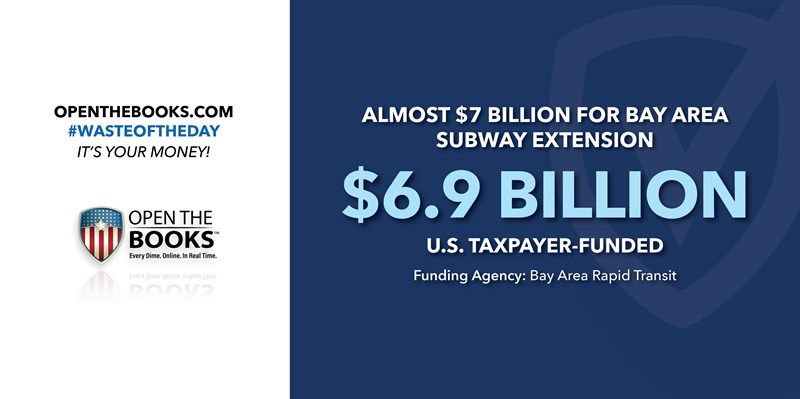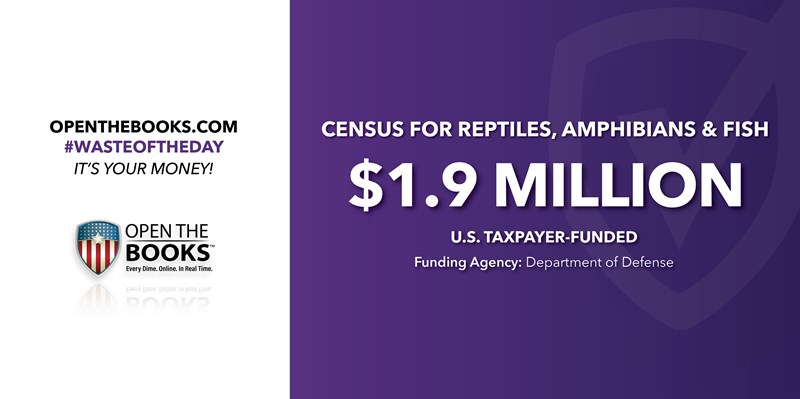
"Pelosi’s Subway" — Bay Area Rapid Transit Subway Extension Now Costs $6.9 Billion | August 2, 2021

A San Francisco Bay Area subway extension originally estimated to cost $4.7 billionnow has a $6.9 billion price tag and its start date has been pushed back three to four years.
The project to extend Bay Area Rapid Transit service through downtown San Jose will cost more than $1 billion per mile. The project is requesting $1.7 billion in federal funding. Congress has already provided $225 million.
U.S. Senator Joni Ernst (R-Iowa) gave the U.S. Department of Transportation a July 2021 Squeal Award “for allowing taxpayers to be taken for a ride on this gravy train that is billions over budget.”
Furthermore, Ernst authored a bill that would prohibit spending federal money on transportation projects where cost overruns exceed $1 billion.
Congressional Democrats tried to insert a $141 million earmark into the American Rescue Plan Act of 2021 in March. Republicans called the project the "Pelosi Subway" and the earmark was eventually scrapped. Congress is currently debating the infrastructure bill and pork is back on the table.
The project is a six-mile, four-station extension, with a 4.7-mile tunnel under downtown San Jose, and its construction is based on a method pioneered in Barcelona intended to lower costs and minimize street level disruptions.
But the Spanish project cost less than $250 million per mile, while the BART extension is set to cost more than $1 billion per mile.
“Not a whole lot of places anywhere are doing big things well,” spokesman for the Metropolitan Transportation Commission Randy Rentschler said. “But, the Bay Area is doing it worse.”
The subway is being built by one transit agency, the Santa Clara Valley Transportation Authority, but BART will run it. That has caused years of complications between the two agencies over project plans.
Out-of-control projects like the BART extension must have its federal funding cut off to send a message that taxpayer dollars are valued and not to be wasted.
Running Lizards on Treadmills Costs Taxpayers $1.6 Million | August 3, 2021

We remember when taxpayers paid $1.3 million to run shrimp on treadmills. U.S. Senator Rand Paul just discovered that lizards are more expensive: the National Science Foundation (NSF) wants to spend $1.6 million.
Running lizards on treadmills is part of the United States Innovation and Competition Act of 2021, formerly known as the Endless Frontier Act, sponsored by Sens. Chuck Schumer (D-NY) and Todd Young (R-IN), authorizing $110 billion for technology research over a five-year period.
The bill proposes spending on research such as artificial intelligence, high performance computing, and advanced manufacturing, and the commercialization of those technologies to businesses in the U.S.
Proponents argue the funding to expand science and technology research will help the U.S. compete with China.
But Paul said with the national debt at $28 trillion and growing, the U.S. should be reining in wasteful spending and not borrowing more money from China to fund such legislation.
"I don’t think this bill makes us stronger,” Paul said, according to Fox News. “In fact, I think the Chinese sit back … and laugh at America thinking we’re going to be stronger by borrowing more money from China.”
For context, the national debt was $5.8 trillion at the start of George W. Bush's term, $19.9 trillion at the end of Barack Obama's term, and $28 trillion at the end of Donald Trump's term.
$180,000 Funded by Taxpayers to Study Tanzania’s Poultry Products | August 4, 2021

Ever wonder about the poultry meat and egg supply chain and market system in Tanzania?
Someone will be researching it with $180,000 from the Department of Agriculture.
The USDA is funding the grant so that using “quantitative, qualitative, and mixed-methods approaches, such research would identify existing barriers to trade, gaps in technical assistance, and capacity building opportunities to increase the availability of poultry products to Tanzanian consumers, through increased local production and imports.”
The grant recipient will collaborate with the USDA’s Foreign Agricultural Service to survey importers, distributors, wholesalers, retailers, institutional buyers, food product manufacturers and processors, local government and trade associations, government policy makers and consumers.
The research program will look at the poultry meat and egg domestic suppliers and importers in Tanzania, as well as transshipment to and from neighboring countries.
Researchers will consider the market for U.S. agricultural exports of poultry products to Tanzania and how to expand that market.
They will explore Tanzania’s agricultural trade policies on poultry meat, eggs, and feed, “and how those policies may be affected by the recent change in the government.”
At the end, researchers will recommend methods the Tanzanian Ministry of Livestock and Fisheries Development can use to identify trade opportunities and market trends to improve two-way trade with the U.S.
Dear John PR Campaign—Encouraging Americans to Write Letters Cost Postal Service $19 Million | August 5, 2021

Throwback Thursday!
In 1977, U.S. Sen. William Proxmire gave a Golden Fleece Award to the U.S. Postal Service for spending $3.4 million — $15 million in 2021 dollars – on an ad campaignbetween 1975-1976 to encourage Americans to write more letters to one another.
But it gets worse. Then, the Postal Service spent another $775,000 to study whether the campaign worked, costing taxpayers more than $4 million in inflation adjusted 2021 dollars.
Total cost: $19 million in 2021 dollars.
The Postal Service was trying to drum up more business for itself, a dubious task at best, the senator noted.
Proxmire compared the quasi-government agency’s behavior to a hypothetical scenario in which the Defense Department started a war so that it could use military hardware.
In its defense, the Postal Service said it expected to generate more first-class mail, which would produce more revenue.
But that didn’t happen. The Postal Service indicated then that all mail classes were losing money.
By 1976, the Postal Service deficit was almost $1.2 billion, about $5.6 billion in 2021 dollars.
And the $775,000 they used to study the effects of the ad campaign wasn’t money well spent. Postal Service bureaucrats were unable to agree on what the results were and indicated they might spend another $1 million for additional testing in 1978.
The Fish, Frogs, and Snakes Census at Edwards Air Force Base Could Cost Taxpayers $1.9 Million
| August 6, 2021

Just how many reptiles, amphibians, and fish live on the property of the Edwards Air Force Base in California will be determined by spending up to $1.9 million on a census.
The Department of Defense will fund the grant at the Air Force base, spread over Kern, San Bernardino and Los Angeles counties “to provide base-wide inventory” of reptiles, amphibians and fish.
Considered a grant for “Conservation and Rehabilitation of Natural Resources on Military Installations,” it awards around $311,512 at first, with additional funding in subsequent years, up to $1.9 million total.
The base encompasses more than 300,000 acres in the Antelope Valley and is in the western Mojave Desert, where fish and wildlife program management focus on conserving the habitat.
The native wildlife includes lots of invertebrates, reptiles, amphibians, birds, and mammals that are adapted to various desert habitats on base, according to the grant summary.
“Periodic fauna surveys are conducted to determine fauna presence, trends, and viability of various animal species. Long-term monitoring is a fundamental aspect of adaptive management to determine the overall health of the ecosystem and allow a focused and cost-effective monitoring program,” the grant states.
The DOD is looking for field technicians who have at least five years of experience conducting point count surveys and who are able to “accurately identify riparian birds by sight and audibly and estimate distance and direction using common field instruments,” among other things.
Protecting animals in their native habitats is important but spending $1.9 million on a census is for the birds.
The #WasteOfTheDay is presented by the forensic auditors at OpenTheBooks.com.